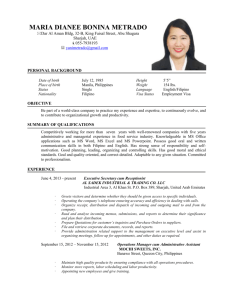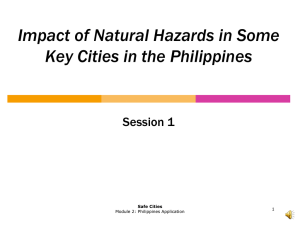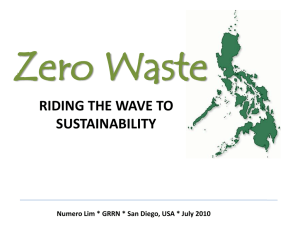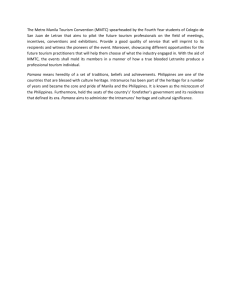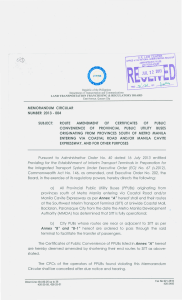“West is Best” Trends in the Philippines
advertisement
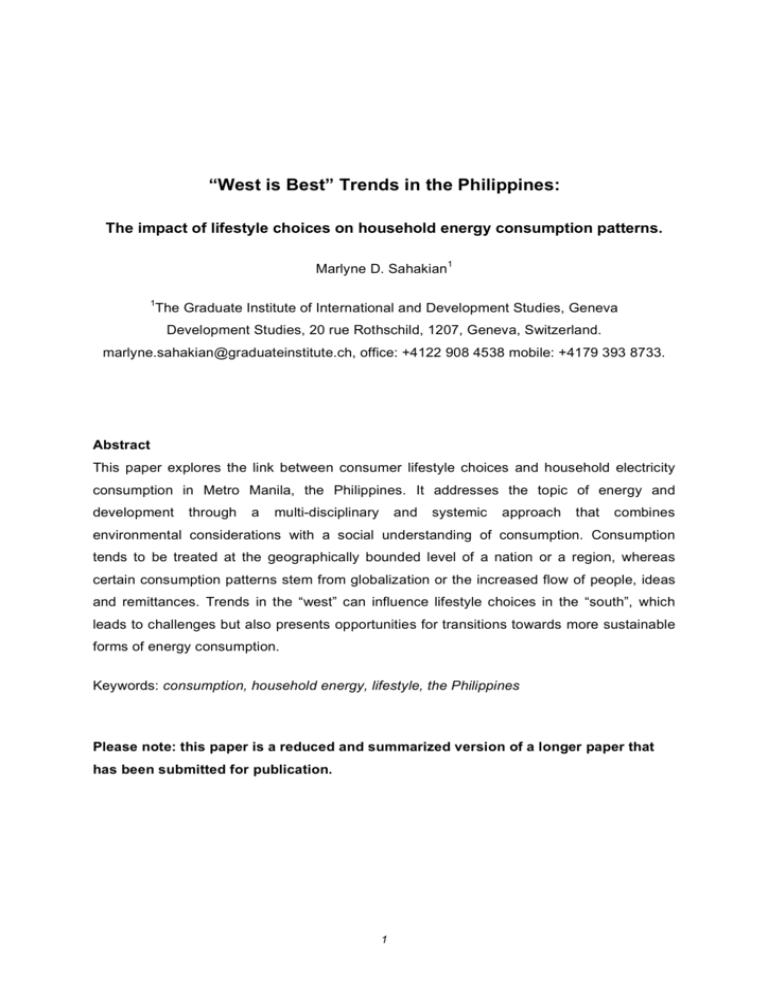
“West is Best” Trends in the Philippines: The impact of lifestyle choices on household energy consumption patterns. Marlyne D. Sahakian1 1 The Graduate Institute of International and Development Studies, Geneva Development Studies, 20 rue Rothschild, 1207, Geneva, Switzerland. marlyne.sahakian@graduateinstitute.ch, office: +4122 908 4538 mobile: +4179 393 8733. Abstract This paper explores the link between consumer lifestyle choices and household electricity consumption in Metro Manila, the Philippines. It addresses the topic of energy and development through a multi-disciplinary and systemic approach that combines environmental considerations with a social understanding of consumption. Consumption tends to be treated at the geographically bounded level of a nation or a region, whereas certain consumption patterns stem from globalization or the increased flow of people, ideas and remittances. Trends in the “west” can influence lifestyle choices in the “south”, which leads to challenges but also presents opportunities for transitions towards more sustainable forms of energy consumption. Keywords: consumption, household energy, lifestyle, the Philippines Please note: this paper is a reduced and summarized version of a longer paper that has been submitted for publication. 1 1. Introduction As the world’s population concentrates in urban centers, policy-makers will increasingly be faced with the challenge of addressing the energy needs of urban populations. Asia is poised to be the main driver of a 40 percent expansion in global energy demand over the next two decades, with Southeast Asia’s energy demand expected to expand by 76 percent from 2007 to 2030 (WEO 2009). Fossil fuels will account for approximately 77 percent of the increase in global energy use by 2030, with coal expected to remain the dominant fuel of the power sector earning itself the title of ‘king coal’ (Fernando, Venezia et al. 2008). The main question for Southeast Asia is how to recognize the negative affects of regional fossil fuel combustion on the global atmosphere, as well as the question of access to energy, with inequalities existing within countries, and between regions. Current policy measures, however, often fail to take under consideration both biophysical criteria for determining environmental priority areas in regards to energy consumption patterns, and a social understanding of energy consumption in households to better understand its drivers. This paper analyzes household electricity consumption in Metropolitan Manila, the Philippines. The aim of this paper is to determine how a deeper understanding of energy consumption patterns among consumers can lead to more effective measures for curbing energy consumption in the home. A focus will be placed on electricity usage for cooling and lighting in order to assess what consumption patterns are developing and what might be done to prevent continued increase in electricity consumption. 2. Conceptual Framework In this paper, a multi-disciplinary and systemic approach combines environmental considerations of energy usage from a life-cycle perspective with a social understanding of consumption grounded in economic anthropology. Because of the vast amount of research that has been proposed around the theme of consumption in social theory, Richard Wilk’s approach helps simplify these themes in three main categories: a social approach to consumption builds on the work of Veblen (1994 / 1899) and Bourdieu (1979), and considers consumption as involving relations among people (and power structures) as well as forms of social belonging (including status); a cultural approach to consumption sees goods as coded for communication, or as symbols that bear meaning (Baudrillard 1968; Douglas and Isherwood 1979; Appadurai 1986). Finally, Wilk does not exclude individual choice, and thus proposes a ‘multigenic’ approach to consumption that combines all of three perspectives. 2 Consumption can also be understood in its biophysical aspect, as a using up of resources with a consideration for throughput, growth, scale, and patterns of resource use (Princen, Maniates et al. 2002). The central question is how to reduce energy and material usage in a way that avoids resource depletion as well as local and global pollution, while also allowing for higher standards of living for more people and a more equitable sharing of the global resource pie. For this, “life cycle thinking” is relevant: a concept derived from the Life Cycle Assessment (LCA) analytical tool that evaluates all material and energy used by a product or service throughout its life cycle, “from cradle to grave”. This holistic approach considers inputs and outputs from the extraction of raw materials and production processes upstream, to usage and final disposal downstream. A biophysical understanding of consumption based on life cycle thinking can help establish priority areas for environmentally significant consumption. The influence of globalization on consumption is also explored in this paper, including the global flow of images, people, remittances and brands. Metro Manila, much like many urban centers, is a space where moving images meet mobile audiences, to use Appadurai’s language (1996). Migration represents an important livelihood strategy in the Philippines, with remittances contributing to over 10% of GDP. Known as Overseas Filipino Workers (OFWs), millions of Filipinos work abroad in a given year and many more have become part of a large diaspora of approximately 8 million (Republic of the Philippines 2008). The impact of migration on consumption is little understood to date (Wilhite 2008), however. 3. Methodology The methodological approach used in this paper combines environmental science with social science. The quantitative data presented in the Context section below speaks to the scientific and environmental relevance of addressing housing consumption in general, and electricity usage specifically in Manila. Qualitative data, based on semi-structured interviews with and observations among households in Metro Manila provides insights into what meanings people give to electricity usage. Evidence was drawn from interviews with and observations among different socio-economic household groups in Metro Manila, in order to address the question of intra-city inequalities. Three neighborhoods of different socioeconomic standing where therefore used as sample areas: a former squatter community in Tondo; middle-income houses and apartments in Malate; and the gated communities of the affluent in Makati. Thirty-four interviews were conducted in 2008 then transcribed. 3 Observations took place between 2005 and 2008 in both private homes on social occasions and in public spaces. 4. Context: The Philippines, Metro Manila and Energy Consumption Electricity generation depends on the energy sources in specific regional contexts, which can then inform the type of associated emissions. Understanding energy consumption patterns must therefore be placed in relation to life cycle thinking and a local/regional context, specifically that of the electricity grid and primary energy sources. The Philippines is one of the biggest energy importers in the Asian region, importing 95 percent of its primary oil requirements and 77 percent of its coal supply in 2006 (Asian Development Bank 2009). In terms of electricity, total installed generating capacity for the Philippines as of December 2007 was 15,937 MW. Coal-fired power plants accounted the largest share in terms of installed capacity, contributing 4,213 MW or 26.44 percent of the national mix. A majority of these coal plants, however, are located in Luzon grid, where Metro Manila is based. Where in 2007, coal-fired plants accounted for 27 percent of the total national mix, in Luzon and for 2006, coal-powered energy represented 14,417,796 MWh of the national total demand of 16,837,096 nationwide, or 85.6 percent of national demand. At a regional level and for Luzon, residential sector demand represented the highest share of total energy demand in 2007. At the national level and based on a 2004 Household Energy Consumption Survey with data collected nationwide, 14.9 million Filipino households rely on electricity as a major source of energy or 88 percent of all households, up 3.7 percent between 1995 and 2004; electricity remains the primary fuel used by households; gasoline and diesel usage increased in proportion to household family income increases (NSO/DOE 2004). In terms of energy types and according to IEA data (2007), electricity grew at more than twice the rate of overall energy, and experienced a per capita increase of 85 percent since 1975. Carbon emissions for a region also need to be placed in relation to energy sources: for Metro Manila, recent reports developed under the Kyoto Protocol’s Clean Development Mechanism for waste-toenergy projects in Manila refer to an emission factor of 0.557 kg CO2e / kWh for the Manila grid (SSC-CDM-PDD 2009), slightly higher than the Filipino average of 0.523 kg CO2 / kWh (Boden and Marland 2009) which can be explained by a higher reliance on coal in Manila’s electricity mix as compared to the rest of the country. National statistics point to the high frequency of electricity consumption for lighting: 92.1 percents of households nationwide use a form of lighting, with a vast majority using the 4 traditional light bulb. Lighting is therefore an interesting area for studying electricity usage among different socio-economic groups. While a smaller percentage use electricity for cooling (66.6%), the use of cooling devices is of interest because of the high rate of energy consumption for air-conditioning (used by just under 9% of households nationwide). Among households, electric fan usage is pervasive but is less energy intensive than air-conditioning. There tends to be a strong correlation between household income levels and the types and amounts of fuels used, leading to the notion of a fuel-income ladder to explain a switch to more convenient fuel in households (Sathaye and Tyler 1991). Manila is the most affluent urban center in the Philippines, and boasts higher incomes that elsewhere in the country. While there are no statistics are readily available for energy usage at the level of households in Metro Manila, we can assume that air-conditioning usage is much higher than 9% in the nation’s capital region. In the following section, research results are presented and discussed. These results are drawn from a lengthier paper and have been summarized here. 5. Research Results and Discussion In terms of understanding what role consumers might play in transitioning towards a reduction in energy consumption in Metro Manila, a social and life cycle approach to electricity consumption reveals the following main findings. The research focus is on the use of cooling and lighting among different socio-economic groups. 5.1. Air-conditioning: a status symbol for return migrants and social service for the affluent Air-conditioning units, as products, have a very specific cultural meaning among certain groups: for Filipino return migrants, air-conditioning is perceived as a status symbol or an achievement of financial success abroad. Overseas Filipino Workers (OFWs, an acronym used by the Filipino government) homeowners were observed to have placed airconditioning units exclusively in the front window of their new homes, in order to display their purchase. Real-estate developers also promote model homes that showcase the airconditioning unit in this position. In addition, air-conditioning is linked to concepts of bodily comfort that are socially constructed and have changed over time (Shove 2003). All respondents found fans and air-conditioning to deliver greater comfort, particularly for sleeping better, working or socializing – or what we have called the “secondary services” of cooling (for a more detailed analysis of cooling services in Metro Manila, see Sahakian and 5 Steinberger, as soon as published). For higher-income groups, air-conditioning also allows for the following of western fashion trends: cool air is increased to allow for a comfort level when wearing clothes from fall/winter collection of Western fashion runways, despite a tropical climate (from 30°C and 37°C throughout the year, on average). Air-conditioning can therefore be seen as delivering the social secondary service of “display” and “looking cool” (Sahakian and Steinberger, as soon as published). A public policy strategy that aims to reduce air-conditioning usage would need to address these “secondary services” through a social and cultural understanding of consumption. An informational campaign based solely on energy reduction and environmental messages, or based solely on cost savings, would not be effective on its own. As stated in other studies, priority should be given to promoting technologies, which provide the same cultural service with less energy (Wilhite, Nakagami et al. 1996). 5.2 “West is Best” mentality for housing construction by return migrants that “locksin” electricity consumption The largest growing market for new single-unit houses in the Philippines is the OFW market, as explained by architects and real estate developers interviewed. For some, the construction of a house becomes a symbol of success – often building their homes directly in the shanty neighborhoods they had left behind to work abroad. In a survey of households in Kerala, India, Wilhite found that families with a close family member working outside of India have a higher rate of electrical appliance ownership that those without (Wilhite 2008). More than just due to increased affluence, Wilhite argues that “the pull of the family” is at play, or a sense of obligation and reciprocation towards family members by transnationals. For many abroad, supporting family members back home is a social obligation. The real issue is in the long-term usage of houses that mimic the low-ventilation architectural style of Western houses, which are structurally inappropriate for the local tropical climate and “lock in” energy consumption patterns over the long-term (Sanne 2002). “West is Best,” an architect explained, when designing homes for return migrants (Sahakian and Steinberger, as soon as published). Beyond building styles, these houses are often built facing the famous Manila sunset, with direct exposure to sunlight in an East-West position, and are therefore locking in the need for artificial cooling devices for years to come. What rules govern construction in the Philippines, and how are they maintained? A social understanding of consumption must also consider the power structures at play in the building 6 and construction market. Building codes have no guidelines or targets in place to govern the construction of buildings with natural ventilation, and indeed existing building codes are not always enforced. 5.3 Influence of globalization on Filipino environmental trends Beyond the flow of people and remittances, local populations are also influenced by media and the flow of ideas, images and messages across the globe. Media also plays a role in influencing local consumption patters. Currently, the government of the Philippines is implementing a Switch to CFL (compact fluorescent lamps) campaign. One respondent from Makati explained why she switched by saying “I saw it on Oprah,” referring to the highly influential American TV show host (Sahakian 2010). Western trends in environmentalism have already had an impact on the environmental movement of the country, which followed closely in the footsteps of the USA movement and was actively engaged in the Rio 1992 summit. Today, there are a multitude of environmental NGOs as well as two larger organizations involved in environmental protection in the Philippines – Haribon and WWF. However, there is currently no concerted effort to focus specifically on consumer activism, as exists in Western countries. Today and in the Philippines, the Consumer International network partner is IBON Foundation, a research institute known for its anti-government stance that tackles a very broad range of socioeconomic issues. Consumer rights and advocacy is not one of their main focus areas. Consumer activism is only modestly visible in the West and is often limited to inciting consumers to act through their purchasing power. The individual consumer is the focus of “green marketing” tactics, with very little efforts around mobilizing the “consumer citizen” (Maniates 2002). However, this could become a growing trend. There is a need to encourage the role of the consumer-citizen in political activity in the Philippines that would voice support and lobby for the policy measures towards reducing energy consumption in Metro Manila and in households throughout the country. The community-based governance structure called barangay would be the best place to begin discussions around life cycle thinking and energy conservation in order to identify the structural barriers hindering change, or opportunities for transitions to less energy-intensive lifestyles. 7 6. Conclusion This paper has outlined some of the ways in which globalization has an influence on lifestyle choices and therefore local consumption patterns. Currently, policy measures focused on sustainable consumption tend to ignore global factors. Transnational spaces and actors – including online media, TV programming, OFW associations, governmental entities focused on diaspora and OFW relations – should be engaged in any holistic approach to redirect consumption patterns towards more environmentally-friendly areas in Metro Manila. These approaches should also address the cultural and social services of energy-intensive products, so that consumers may be incited to reduce energy consumption without major lifestyle changes. While “West is Best” mindsets may lead to climate-inappropriate fashion and architectural styles, western influences have also contributed to the start of the environmental movement in the Philippines. As renewable energies gain in popularity and consumer groups lobby for change in the West, local interpretations of these movements are likely in the Philippines. Starting with efforts at the barangay level could serve to engage community members in discussions around energy and lifestyle. To conclude, research that draws from a multi-disciplinary approach when considering household energy consumption includes a social understanding of consumption drivers, but also a biophysical understanding of consumption patterns. While the research and policy recommendations are based on fieldwork conducted in Metro Manila, the results are relevant to other similar contexts, as energy consumption remains one of the most important issues worldwide. References Appadurai, A. (1986). The Social Life of Things: Commodities in Cultural Perspective. New York, Cambridge Studies in Social & Cultural Anthropology. Appadurai, A. (1996). Modernity at Large: Cultural Dimensions of Globalization. Minneapolis, London, Univetsity of Minnesota Press. Asian Development Bank (2009). Energy Statistics in Asia and the Pacific (1990-2006). Manila, ADB. Baudrillard, J. (1968). Le système des objets. Paris, Gallimard. Boden, T. A. & G. Marland, Andres, R.J. (2009). Global, Regional, and National Fossil-Fuel CO2 Emissions. Oak Ridge, Tenn., U.S.A., Oak Ridge National Laboratory, Carbon Dioxide Information Analysis Center (CDIAC), U.S. Department of Energy. Bourdieu, P. (1979). La distinction critique sociale du jugement. Paris, Les Editions de Minuit. Douglas, M. & B. Isherwood (1979). The World of Goods: Towards and Anthropology of Consumption. New York, Basic Books. 8 Fernando, H., J. Venezia, et al. (2008). Capturing King Coal: Deploying Carbon Capture and Storage Systems in the U.S. at Scale. Washington, DC, World Resources Institute. International Energy Agency (2007). Energy Balances of Non-OECD Countries, 2004-2005, CD-Rom. Maniates, M. (2002). Individualization: Plant a Tree, Buy a Bike, Save the World? Confronting Consumption. T. Princen, M. Maniates and K. Conca. Cambridge, London, The MIT Press. NSO/DOE (2004). Household Energy Consumption Survey: Final Report. ISBN 971-562-664-5, National Statistics Office and Department of Energy. Princen, T., M. Maniates, et al., Eds. (2002). Confronting Consumption. Cambridge, London, The MIT Press. Republic of the Philippines (2008). Stock Estimate of Overseas Filipinos as of Dec. 2008, Office of the President of the Philippines: Commission on Filipinos Overseas. Sahakian, M. D. & J. K. Steinberger (As soon as published). "Energy Reduction Through a Deeper Understanding of Household Consumption: Staying Cool in Metro Manila." Journal of Industrial Ecology. Sahakian, M. D. (2010). "Combining Life Cycle Thinking with Social Theory: Case Study of Compact Fluorescent Lamps (CFL) in the Philippines." Sustainability 2(7): 2349-2364. Sanne, C. (2002). "Willing Consumers – or locked-in? Policies for a sustainable consumption." Ecological Economics 42: 273-287. Sathaye, J. & S. R. Tyler (1991). "Transitions in Household Energy Use in Urban China, India, The Philippines, Thailand, and Hong Kong." Annual Review of Energy and the Environment. 16: 295-335. Shove, E. (2003). Comfort, Cleanliness and Convenience: The Social Organization of Normality. Oxford, New York, Berg. SSC-CDM-PDD (2009). Makati South Sewage Treatment Plant Upgrade with On-Site Power, Version 4. Manila, Clean Development Mechanism, Simplified Project Design Document for Small-Scale Project Activities. Veblen, T. (1994 / 1899). The Theory of the Leisure Class. New York, Penguin Group. WEO (2009). World Energy Outlook. Paris, IEA-OECD. Wilhite, H. (2008). Consumption and the Transformation of Everyday Life: A View from South India. New York, Palgrave Macmillan. Wilhite, H., H. Nakagami, et al. (1996). "A cross-cultural analysis of household energy use behaviour in Japan and Norway." Energy Policy 24(9): 795-803. Wilk, R. (2002). "Consumption, human needs, and global environmental change." Global Environmental Change 12(1): 5-13. 9

